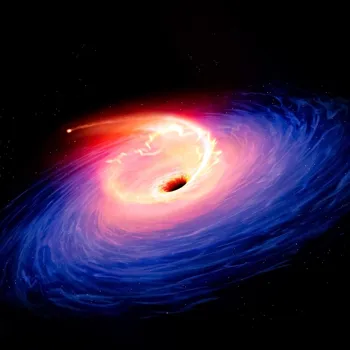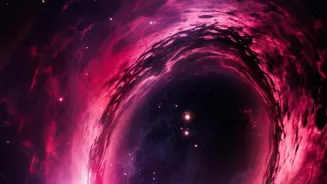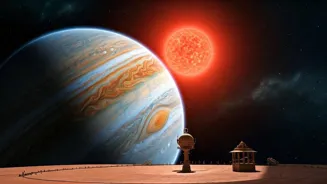Explore the cosmic symphony of galactic evolution, from birth to fate. Unveil the secrets of transforming celestial giants
The universe, a vast and awe-inspiring expanse, is home to countless galaxies,
each a swirling island of stars, gas, and dust. These galaxies aren't static entities; they're dynamic systems, constantly evolving and transforming over billions of years.
Understanding this galactic evolution is a key goal for astronomers, helping them unravel the mysteries of the cosmos and our place within it.
From humble beginnings to majestic spirals or giant ellipticals, galaxies undergo significant changes driven by internal processes and interactions with their cosmic neighbourhood.
This article delves into the fascinating journey of galactic evolution, exploring the key factors that shape these celestial giants.
We'll explore how galaxies are born, how they mature, and how they eventually meet their cosmic fate, shedding light on the grand narrative written across the fabric of space and time.
Galaxies form from smaller structures merging over time
Galaxies don't just pop into existence fully formed. They begin as slight overdensities of matter in the early universe. Imagine the universe shortly after the Big Bang, a hot, dense soup of particles. Tiny fluctuations in density arose, some regions having a bit more matter, than others.
Gravity, the universal sculptor, then took over. These denser regions began to attract more and more matter, gradually growing in size and mass. As matter collapses inwards, it heats up, eventually leading to the formation of stars.
This process, known as hierarchical structure formation, suggests smaller structures emerge first, which then merge to form larger ones, like galaxies. So, our own Milky Way galaxy likely formed through the merger of many smaller dwarf galaxies over billions of years.
These early galaxies were often irregular in shape, possessing chaotic arrangements of stars and gas. They lacked the elegant spiral arms or smooth elliptical profiles we see more prominently today.
Think of them as cosmic building blocks, the raw materials for the grand galactic architectures yet to come.
Galaxies evolve through collisions and interactions shaping their fate
The life of a galaxy is profoundly influenced by its environment. Galaxies rarely exist in isolation. They congregate in groups and clusters, bound together by mutual gravitational attraction. These interactions can dramatically impact a galaxy's evolution.
When galaxies collide, it triggers a burst of star formation, as gas clouds are compressed and collapse, creating new generations of stars. A major merger can completely reshape a galaxy's morphology, transforming a spiral galaxy into an elliptical one.
Imagine two spiral galaxies, each with its own spinning disk of stars and gas, colliding head-on. The collision disrupts their delicate structures, scattering stars and gas in all directions. Over eons, gravity reshapes the remnants into a more rounded, featureless elliptical galaxy.
Even without a direct collision, a galaxy can experience "harassment" from its neighbors. Close encounters can strip away gas and dust, halting star formation and gradually transforming a spiral galaxy into a smaller, less active object.
Galaxies evolve based on star formation rates and external factors
The rate at which a galaxy forms stars is a critical factor in its evolution. Some galaxies, known as "star-forming" galaxies, are actively churning out new stars. These galaxies are typically rich in gas and dust, the raw materials for star formation.
They shine brightly with the light of young, hot stars. Other galaxies, known as "quenched" or "passive" galaxies, have largely ceased forming new stars. These galaxies tend to be older and redder, dominated by aging populations of stars. What causes a galaxy to quench its star formation?
One possibility is that the galaxy has simply used up all its available gas. Another possibility is that the galaxy has been subjected to some external process that removes its gas, such as a merger or harassment.
Supermassive black holes, residing at the centers of most galaxies, are also a significant factor. These behemoths can unleash powerful jets of energy that heat up and expel gas, suppressing star formation.
Supermassive black holes regulate galaxy growth
Supermassive black holes (SMBHs) play a crucial role in the evolution of galaxies. Nearly every large galaxy harbours an SMBH at its centre, millions or even billions of times the mass of our Sun.

When gas and dust fall into the SMBH, it forms a superheated accretion disk that emits tremendous amounts of energy. These active galactic nuclei (AGN) can have a profound impact on the galaxy.
The energy released by the AGN can heat up and ionize the gas in the galaxy, preventing it from cooling and collapsing to form stars. AGN can also drive powerful outflows of gas, which push material out of the galaxy and into the surrounding intergalactic medium.
This "AGN feedback" is thought to be a key mechanism for regulating star formation in galaxies. It helps to limit the growth of galaxies and prevents them from becoming excessively massive. So, surprisingly, these cosmic monsters can also act as regulators, keeping galaxy growth in check.
Studying distant galaxies reveals insights into galactic evolution by looking back in time
Studying distant galaxies provides crucial insights into galactic evolution. Light takes time to travel across vast cosmic distances, so when we observe a distant galaxy, we're seeing it as it was billions of years ago.
By studying galaxies at different distances, we can essentially look back in time and observe how galaxies have changed over cosmic history. For example, observations of distant galaxies have revealed that star formation rates were much higher in the early universe.
This suggests that galaxies were more actively building up their stellar mass in the past. Similarly, studying the distribution of different types of galaxies at different distances reveals how the population of galaxies has evolved over time.
Modern telescopes, both ground-based and space-based, are pushing the boundaries of our observational capabilities, allowing us to peer deeper into the universe and uncover even more secrets of galactic evolution.
AI Generated Content. Glance/InMobi shall have no liability for the content











